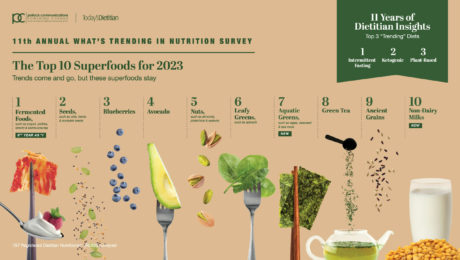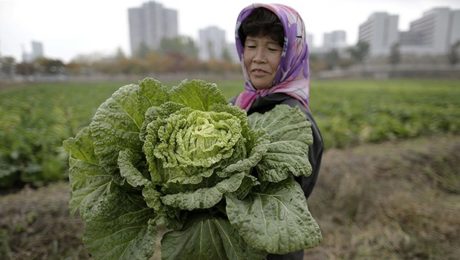Fermented Foods No. 1 for 6th Year
Fermented foods take the top spot in Today’s Dietitian annual list of superfoods for the 6th year in a row.
Registered Dietitian Nutritionists (RDNs) were polled by Today’s Dietitian and Pollock Communications on their views on superfood predictions and grocery shopping habits. The results, published in the 11th annual “What’s Trending in Nutrition” survey, predict how and what consumers will eat. Since 2019, health became the key focus of the superfood list. Striking this year is the new focus on affordable and accessible food.
“After years of keeping immune health and comfort top-of-mind during the COVID-19 pandemic, consumers are back to prioritizing affordability and convenience when shopping for food,” Pollock Communications shared in a statement.
This shift is attributed to the higher cost of groceries “as consumers navigate the cost-of-living crisis.” RDNs predict top purchase drivers are affordability and value (70.4%), ease of accessibility and convenience (59.1%) and immunity support (57.6%).
“Consumers are more aware than ever of the benefits food can provide for gut health and immune function. As consumers face higher costs at the grocery store, they’ll be looking for affordable food and snacks that still provide valuable health benefits,” says Louise Pollock, president of Pollock Communications. “Our survey findings reflect how consumer behaviors are shifting as Covid-19 restrictions loosen, remote work remains and inflation rises – from prioritizing affordable foods to continued interest in snacking.”
The survey highlights fermented food products yogurt, kimchi, kombucha and pickled vegetables. Also noteworthy is that, for the first time in 11 years of conducting the survey, the entire superfoods list is plant-based. The top ten include:
- Fermented Foods
- Seeds, such as chia and hemp
- Blueberries
- Avocados
- Nuts, including pistachios, almonds and walnuts
- Leafy Greens, such as spinach
- Aquatic Greens, such as algae, seaweed and sea moss
- Green Tea
- Ancient Grains
- Non-Dairy Milks
Plant-based diets are becoming more popular, and RDNs note it’s the third most popular diet after intermittent fasting and keto. However, only 1% of RDNs say they would recommend meat alternatives because they are highly processed products.
RDNs are also concerned about where consumers are getting their nutrition information. Social media platforms such as TikTok, Instagram and Facebook are “rife with nutrition misinformation,” but they’re where many consumers turn for nutrition advice.
“Social media influencers are talking about wellness and nutrition at rates never seen before, but people struggle to differentiate between credible information and myths. This only supports the need to amplify credible sources of nutrition information, like registered dietitian nutritionists,” says Mara Honicker, publisher of Today’s Dietitian. “With the survey in its 11th year, we are excited to continue to share insights from these experts in food and nutrition, at a time where the value of food is subject to more scrutiny.”
- Published in Health
Cabbage Shortage Forces Halt in Winter Kimchi
A cabbage shortage is forcing North Koreans to give up winter kimchi making for the second year in a row. They are unable to take part in gimjang, the Korean tradition of communally preparing kimchi each October for the winter season.
Flood damage and poor crop yields led to a poor cabbage (and radish) growing season. The cabbage that was harvested was mostly routed to military and government agencies, “leaving the people empty handed.” Cabbage prices have risen 25% from a year ago, “making a large batch of kimchi cost more than a government-provided monthly salary,” according to Radio Free Asia.
Read more (Radio Free Asia)
- Published in Business, Food & Flavor
Bubbling Over: Why Kimchi Is the Fastest-Growing Fermented Veggie in America
Sales are soaring. Although kimchi only makes up 7% of the pickles and fermented vegetables category, its sales are increasing at an explosive 90% rate, according to SPINS.
We asked three kimchi experts their thoughts on the uptick in sales: Minnie Luong, founder and CHI-EO of Chi Kitchen, JinJoo Lee, chef and Korean Food Blogger at KimchiMari and Kheedim Oh, founder and Chief Minister of Kimchi for Mama O’s (and member of TFA’s Advisory Board).
We asked them: Why do you think kimchi sales are increasing so rapidly?
Minnie Luong: Originating in Korea around 4,000 years ago, kimchi is an iconic food symbolic of hope, trust, and survival that is the perfect food for our current times. One of the world’s most special foods, it elicits delight, storytelling and sharing. In fact, UNESCO has designated kimjang — the traditional way of making and sharing kimchi — a designated intangible cultural heritage of humanity.
Low in calories, high in fiber and big on flavor that’s great for your digestion and gut health, kimchi is uniquely poised to cross over from being a specialty food to a must-have pantry staple for health and wellness enthusiasts, home cooks and those seeking out a satisfying flavor adventure. Its spicy, tangy, umami flavor is convenient and easy to use across a wide range of dishes along with a long shelf life when refrigerated. Just open a jar and it’s ready to go! While kimchi is often seen as a condiment, it should really be considered a vegetable, but one that packs a delicious, probiotic punch. Let’s face it, we could all use more veggies and flavor in our lives!
JinJoo Lee: I think the sales of kimchi are increasing because more and more people are aware of the health benefits of kimchi (loaded with probiotics like many fermented foods) and also are being introduced to the wonderful flavors of it now through many restaurant foods and magazine recipes.
More restaurants have started to use kimchi in their menu because I think chefs have realized kimchi works great in non-Korean dishes such as on hamburgers, pasta, cheese quesadillas and even with Brussels sprouts!
Kimchi has a very deep and complex flavor with an amazing zing that fermented foods have but it also is a perfect balance of sour, spicy, salty, umami and slightly sweet that works well with so many different foods, especially meats and seafood.
Most Americans may know only the spicy napa cabbage kimchi (Baechu Kimchi) but did you know there are over 100 different kimchis? kimchi can be made using all sorts of different vegetables such as cucumber, eggplant, radish, mustard greens, green onions, chives and more.
If made and stored properly, kimchi can last for weeks, months and years and it can be enjoyed throughout all the different stages of fermentation – from the very beginning as fresh tasting to fully ripe to overly ripe and sour then even when it’s aged for years! So kimchi is the perfect fermented food that’s tasty, healthy, versatile and even long-lasting.
Kheedim Oh: With everyone in the world simultaneously experiencing sensations of uncertainty mixed with mortal fears of peer contact, people are drawn to the near mythic powers of kimchi. One of the top 5 healthiest foods in the world (according to Health Magazine). A true superfood. People are attracted to the promises of probiotics. The comfort of supporting their immune systems with each bite. The flavor of fermentation. The addictive nature of how eating good kimchi makes you feel.
The word kimchi has reached a tipping point where it’s no longer just the stinky rotting cabbage from Korea (or wherever) to the acidic/tart vegetable dish that “I had as part of a dish at the insert [trendy fusion restaurant] that I went to and I heard it’s really good for you.” It’s losing its Korean-ness and quickly being subsumed into White American food culture the way that kombucha has already completely become. There are a lot of “kimchis” that are only kimchi through very loose interpretations or are just not real kimchi by any definition, only by name. The culprits being many of the before-mentioned fusion restaurants.
On the other hand, there is the whole DIY home fermentation movement that has been growing year over year. Educating themselves on how to achieve food sovereignty, they tend to be a more culturally sensitive crowd. Regardless of the hype surrounding the word, we hope that kimchi can maintain its popularity in America while maintaining its unique UNESCO World Heritage recognized cultural identity as a Korean food.
- Published in Business, Food & Flavor



